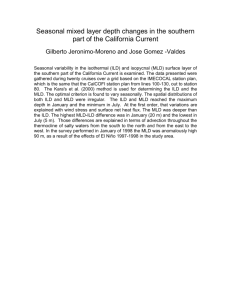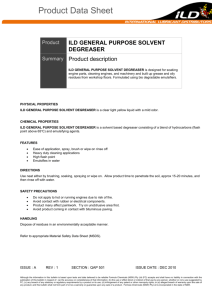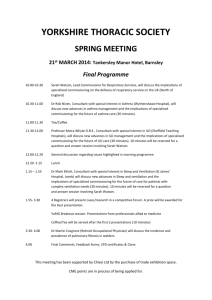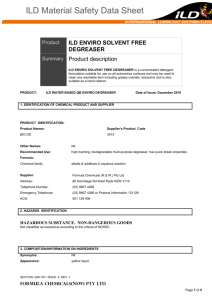Network Cabling & Bit Error Rate Performance Analysis
advertisement
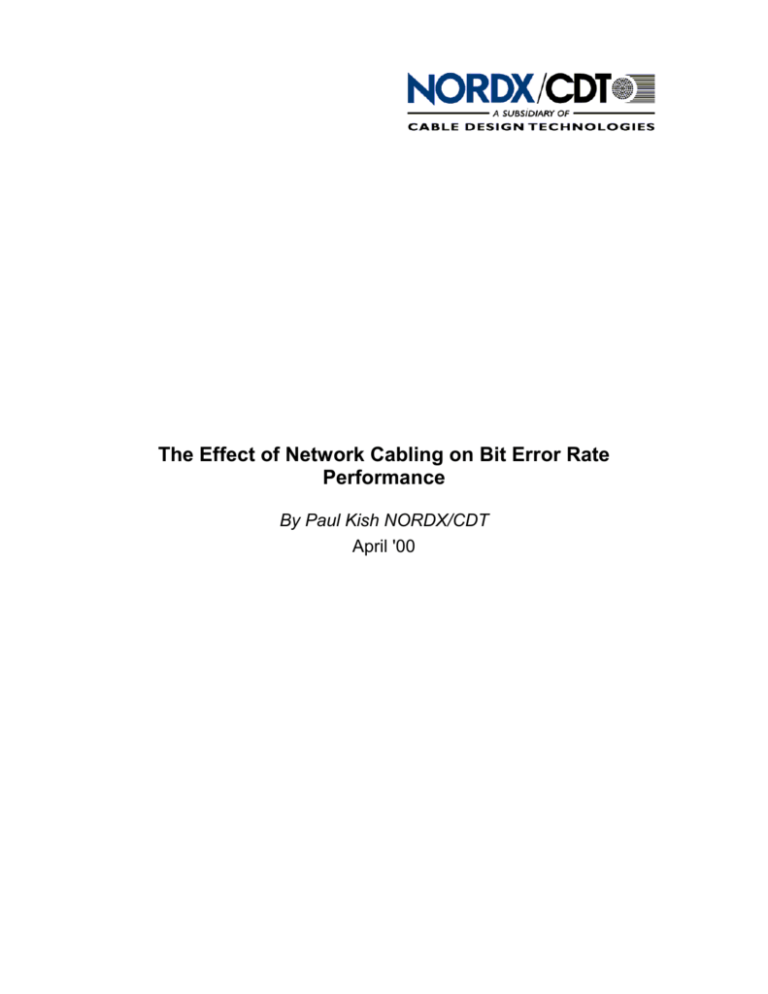
The Effect of Network Cabling on Bit Error Rate Performance By Paul Kish NORDX/CDT April '00 Table of Contents Introduction............................................................................................. 2 Probability of Causing Errors....................................................................... 3 Noise Sources Contributing to Errors........................................................... 4 Bit Error Rate due to NEXT.......................................................................... 4 Insertion Loss Deviation (ILD).......................................................................6 Bit Error Rate due to ILD.............................................................................. 9 Conclusion............................................................................................... 12 Page 1 of 12 INTRODUCTION There is a new buzzword in the cabling industry called “zero bit error rate”. What do we mean by zero bit error rate? How do we measure bit error rate? What causes errors in digital transmission systems? How can we relate the number of bit errors to the performance of a channel? This white paper will look into the whole concept of bit error rates, first to provide an understanding of the underlying fundamentals and second to try and put a handle on this elusive concept. So let’s have a closer look at what we mean by bit error rates. Is it an issue that we need to be concerned about for Category 5, Category 5e or Category 6 channels? The issue of bit error rate (BER) is addressed by the Institute of Electrical and Electronic Engineers (IEEE), which is the organization in the industry that sets the standards for data networking. The IEEE has published a number of standards over the last 10 years. One of the most influential data-networking standards in the industry is 10BASE-T Ethernet, which is designed to run over minimum Category 3 twisted pair cabling. It has gained a reputation in the industry as being a very robust and reliable network. Today, there is a migration from 10BASE-T Ethernet to fast Ethernet (100BASE-TX), which is designed to run over minimum Category 5 cabling. There is a perception in the industry that fast Ethernet is not as robust and is more susceptible to errors due to cabling and equipment related imperfections. In this paper we will examine the types of cabling imperfections that can generate errors. The reader may be surprised at the outcome. A realistic objective for 100BASE-TX is a worst case BER of 10-10. This means that the number of bit errors should not exceed 1 error in 10,000,000,000 bits (10 billion bits) of information. For an information transfer rate of 100 Mb/s, this translates to a maximum of 1 error every 100 seconds. Within the Ethernet protocol, bits of information are packaged into frames. Any error that is detected within a frame would signal a retransmission of the affected frame. A maximum BER of 10-10 is a reasonable upper limit for errors. A BER significantly in excess of this will start to affect data throughput and slow down network performance. Page 2 of 12 Probability of Causing Errors Before a signal is transmitted over a channel, the bits of information are coded into symbols using digital modulation techniques. One common technique is called Pulse Amplitude Modulation (PAM). For this modulation scheme, a symbol is encoded into discrete signal levels. For example, a two-level symbol can be used to represent one bit of information (binary 1 or 0). The conversion or coding of these symbols into real, temporal waveforms to be transmitted over a channel is called line coding. Error Probability (PAM) 0 5 10 15 20 25 30 1.00E+00 1.00E-01 Symbol Error Probablilty 1.00E-02 1.00E-03 1.00E-04 1.00E-05 1.00E-06 1.00E-07 P(e) M=2 P(e) M=3 P(e) M=5 1.00E-08 1.00E-09 1.00E-10 1.00E-11 1.00E-12 1.00E-13 1.00E-14 1.00E-15 1.00E-16 Signal-to-Noise Ratio (dB) Figure 1 - Probability of error, P(e), for PAM signals, where M is the discrete number of signal levels assuming a white Gaussian noise process. The performance of a modulation scheme is measured by its symbol error probability P(e), which is the probability that a waveform is detected incorrectly. There is a fundamental relationship between the probability of error P(e) and the signal-to-noise ratio (SNR) of a channel. The Symbol Error Probability is shown in Figure 1 as a function of the SNR for PAM signals having (M) discrete signal levels. The bit error probability Pb(e), which is equal to the BER, is derived from the P (e ) symbol error probability using the simple relationship ≤ Pb (e) ≤ P (e) log 2 M Page 3 of 12 From the above, we can conclude that there is no such thing as a zero bit error rate. In practice, if the noise level is sufficiently small, then the probability of causing an error is some very small number such as 10-12 or less but not zero. We can also conclude that in order to achieve a BER of 10-10 the SNR needs to be greater than 13 dB for PAM-2, 16 dB for PAM-3 and 18 dB for PAM-5 coding, respectively. Noise Sources Contributing to Errors There are different types of noise sources that can contribute to errors in digital transmission systems. These can be either externally generated or internally generated. For the purpose of this paper we will look at internally generated noise due to transmission impairment of a channel. Fast Ethernet (100BASETX) operates over a channel that uses two pairs, one pair for each direction of transmission. For this application, the dominant internally generated noise sources include 1) Near End Crosstalk (NEXT) interference, and 2) an added noise component that is related to Insertion Loss Deviation (ILD). The latter noise source may come as a surprise to some readers since it is not a specified parameter for Category 5 channels. In fact, this paper will show that ILD noise can be, by far, much worse than NEXT for worst case Category 5 channels. Bit Error Rate due to NEXT The noise component due to NEXT is illustrated in Figure 2 below for the100BASE-TX application R2 IL2 Insertion Loss 100 Mb/s S2 100 Mb/s NEXT N32 100 Mb/s 100 Mb/s S3 Figure 2 – Near End Crosstalk noise between a transmit pair and a receive pair for 100BASE-TX Page 4 of 12 For the configuration shown in Figure 2, the SNR in dB is determined using equation (1), i.e. by subtracting the total noise power due to NEXT from the total signal power at the receiver. SNR = 10 log( ∫ 150 1 S 2 − IL 2 S 3 − N 32 150 10 10 df ) − 10 log(∫1 10 10 df ) …(1) where, S2 ~ S3 = Power spectrum of the transmit signal on pair 2 and 3, respectively For this calculation, the power spectrum of the noise and receive signals are given by the terms (S3 – N32) and (S2 – IL2), respectively. The total power of the noise and receive signals is determined by integration over the frequency band from 1 to 150 MHz. To perform this calculation, the power spectrum of a 100BASE-TX signal was obtained from measurements using a spectrum analyzer as illustrated in Figure 3. Signal Spectral Density Calculated Power = 11.52 dBm 0 Spectrum Setting for trace measurement Center Freq. 1 Span Freq. 150 Resolution BandWidth 300 kHz Reference Level 0 -10 -20 dBm -30 -40 -50 -60 -70 0 20 40 60 80 100 120 140 160 Frequency (MHz) Figure 3 – Power spectrum of a 100BASE-TX signal measured at the output of the transmitter Using the worst case parameters for a Category 5 channel the signal-to-noise ratio due to NEXT works out to be 30 dB over the complete frequency band from 1 to 150 MHz. This is significantly better than the16 dB threshold that is required to achieve a BER of 10-10 for MLT3 (3-level coding). From this, it is concluded that NEXT for a Category 5 channel is not a major contributor to system error rates for the 100BASE-TX application. Page 5 of 12 Note: For comparison purposes, the SNR due to NEXT was calculated by substituting a Category 3 cable instead of Category 5 (keeping the same connectors). For this case, the SNR works out to be 10 dB. This is 6 dB worse than the required SNR to achieve a BER of 10-10. From Figure 1, this would lead to an excessively high BER of ~ 10-3. Insertion Loss Deviation (ILD) Insertion Loss Deviation (ILD) is a new parameter for many readers. It is important to get a good understanding of what it is and why it is so important. A channel, as specified in the TIA/EIA 568-A standard, is made up of components that include cords, connectors and cables. In a worst case configuration, a channel can include up to four connectors (two at each end), an equipment cord, a patch cord, a horizontal cable, a furniture cable (part of horizontal) and a work area cord. All these components can be characterized as having an insertion loss (also called attenuation) and an impedance. Traditionally, the total insertion loss of a channel is determined by adding up the loss of all the components and calling it the channel insertion loss. All the formulas for a Category 5 and Category 5e channel model in the TIA standard make the assumption that the whole is equal to the sum of the parts. The problem is that it is only an approximation. It is a good first approximation, but the channel insertion loss is in fact higher than the just adding up the loss of each component. The additional losses are due to signal reflections and re-reflections at the boundaries between different components, as illustrated in Figure 4. Signal in Signal out re-reflected signal ILD = additional losses due to signal reflections Figure 4 – Insertion Loss deviation (ILD) is due to impedance mismatch between components Page 6 of 12 The greater the impedance mismatch between components, the higher the mismatch losses. What makes it even more interesting is that at some frequencies these signal reflections can add in phase and at other frequencies they can add out of phase. Therefore, these additional losses are not uniform, and will vary depending on the length of patch cord, the number of connectors, the length of channel, etc. The difference between the actual Insertion Loss as measured on a channel and the Insertion Loss as determined by adding the component losses is called the Insertion Loss Deviation. What is the expected ILD for Category 5, Category 5e and Category 6 channels? This was determined using a channel model as described in Annex H of TIA/EIA 568-A-5. It consists of a series of concatenated transmission lines where each component is modeled by its own transmission matrix [T], where [T] is described in terms of its A,B,C,D parameters. The overall transmission matrix of a channel is then determined by matrix multiplication. For the results reported in this paper, the following channel configuration was used for modeling purposes and was maintained fixed throughout, except for changing out the components. Signal In Equipment 2m 2m Outlet Cross-connect CP 85 m 6m 5m Signal Out Figure 5 – Channel configuration used for ILD modeling including 4 connectors (100 meters) Page 7 of 12 The ILD was determined for the following cases: 1. 2. 3. 4. 5. Cat 5 cable (105 Ω), cord (90 Ω) & connector (14 dB RL @ 100 MHz) Cat 5 cable (105 Ω), cord (85 Ω) & connector (14 dB RL @ 100 MHz) Cat 5e cable (105 Ω), cord (95 Ω) & connector (20 dB RL @ 100 MHz) Cat 6 cable (103 Ω), cord (97 Ω) & connector (24 dB RL @ 100 MHz) Cat 6 cable (101 Ω), cord (99 Ω) & connector (24 dB RL @ 100 MHz) The ILD results are presented in Figure 6. The modeling results for a Category 5 channel, labeled as Cat 5-1 and Cat 5-2, show a considerable deviation with significant peaks of approximately 0.3 dB in the range from 10 to 20 MHz and 1.4 dB at 100 MHz. The cord length of 4 meters (2 m + 2 m) and the difference in impedance between the cord and the cable of 15 Ω and 20 Ω respectively were deliberately chosen at the extreme end of the tolerance range for Category 5. This was done in order to simulate a worst case condition for the 100BASE-TX application where the bulk of the signal energy is less than 30 MHz. The results for a Category 5e channel are much better with an ILD of less than 0.1 dB below 30 MHz and maximum ILD of less than 0.5 dB at 100 MHz. The Category 6 results are also reported for comparative purposes. They do not represent the worst case, but are representative of the type of results that can be achieved using very well matched components. Insertion Loss Deviation 2.5 2 ILD Cat6-1 ILD Cat6-2 ILD Cat5e ILD Cat5-1 ILD Cat5-2 dB 1.5 1 0.5 0 0 20 40 60 80 100 120 140 160 Frequency (MHz) Figure 6 – Insertion Loss Deviation Modeling Results for Category 5, 5e and 6 channels Page 8 of 12 Bit Error Rate due to ILD Now comes the interesting part. Let’s have a closer look at the ILD results in Figure 6. The obvious question is does it really matter? So what if there is a deviation (additional losses) of something like 0.5dB over most of the operating frequency range for 100BASE-TX. Is it really significant? It seems like such a small number. The answer comes by asking another question. What causes ILD? ILD is caused by another signal that is superimposed or is riding on top of the receive signal. This superimposed signal appears as a noise source at the receiver. In this paper it is referred to as an equivalent ILD noise source and is designated by the term (ILX). ILX is the level of noise in dB that when added (as a power sum) to the primary signal produces the observed value of ILD. Note: It should be noted that the results obtained using this approach tend to be conservative, i.e the equivalent noise level may be higher than what is obtained when ILD is determined using a least squares curve fit through the measured insertion loss data. This means that the BER performance for a given mismatch condition may be better than what is predicted, i.e. the error is on the safe side. Table 1 below illustrates how this calculation is performed. The first column is the primary signal at the output of a channel having an Insertion Loss (IL), where it is assumed that all components have the same impedance. The second column is the noise component ILX that is riding on top of the signal and represents the effect of impedance mismatches. The third column is the resultant signal and is calculated as the power sum of the primary signal plus the noise component. The fourth column is the Insertion Loss Deviation (ILD) and is calculated as the difference between the third column and the first column. Page 9 of 12 For example, using Table 1, if the measured Insertion Loss is 20.5 dB and the expected Insertion Loss assuming matched components is 20 dB, then the ILD of 0.5 dB and would be caused by an ILX noise component of ~ 30 dB. IL (dB) 20.0 20.0 20.0 20.0 20.0 20.0 20.0 20.0 20.0 20.0 20.0 20.0 20.0 ILX (dB) 40.0 38.0 36.0 34.0 32.0 30.0 28.0 26.0 25.0 24.0 23.0 22.0 21.0 Psum( IL + ILX ) (dB) 20.04 20.07 20.11 20.18 20.28 20.46 20.75 21.26 21.65 22.20 23.02 24.33 26.87 ILD (dB) 0.04 0.07 0.11 0.18 0.28 0.46 0.75 1.26 1.65 2.20 3.02 4.33 6.87 Table 1 – Determination of the equivalent noise (ILX) that yields a corresponding value of (ILD) The SNR due to ILD noise is derived using equation (2) and is similar to the derivation for NEXT noise except that the term (S2 – ILX2) is substituted for the term (S3 - N32). SNR = 10 log( ∫ 150 1 S 2 − IL 2 S 2 − ILX 2 150 df ) 10 log( − 10 10 ∫1 10 10 df ) …(2) where, S2 = Power spectrum of the transmit signal on pair 2 The results of this derivation are shown in Figure 7. Using the worst case parameters for a Category 5 channel, the signal-to-noise ratio (SNR) due to ILD noise works out to be 14.2 dB for a 20 Ohm impedance mismatch between the cord and the cable and 16.5 dB for a 15 Ohm impedance mismatch. This illustrates that under certain worst case conditions, a Category 5 channel is really borderline compliant for 100BASE-TX application, Surprise! What does this mean in practice? This situation is unlikely to occur in practice except when the user cords and cables are at the extreme ends of the Category 5 tolerance range. That is why it is so important that all the components are designed to work together as part of an end to end solution. Page 10 of 12 ILD Equivalent Noise 70 60 SNR=31.6 dB Att dB ILX Cat6-1 IL Cat6-1 IL Cat5-1 ILX Cat5-1 IL Cat5-2 ILX Cat5-2 NEXT Cat5 ILX Cat5e ILX Cat6-2 50 SNR=25.5 dB dB 40 30 SNR=21 dB SNR=16.5 dB 20 SNR=14.2 dB 10 0 0 20 40 60 80 100 120 140 160 Frequency (MHz) Figure 7 – Insertion Loss Deviation shown as an equivalent noise source for different channels and the corresponding SNR for these channels for a 100BASE-TX application The other important result is that a Category 5e channel, which is specified with tight tolerances on component return loss (a good measure of impedance mismatch), achieves a SNR of 21dB. This provides a 5 dB margin above the SNR objective for 100BASE-TX and a 3 dB margin for 1000BASE-T. A Category 6 channel (proposed), using well-matched components, provides much higher margins. Page 11 of 12 Conclusion Network managers are concerned about the reliability and performance of their data networks, which are increasingly becoming an essential lifeline to their dayto-day business operations. Loss of a network or a slowdown in performance can be very costly. Network performance depends on the ability of the network cabling to support data rates of 100 Mb/s today and 1000 Mb/s or higher tomorrow. An important question to ask is - Does my cabling system have the built-in performance margin to deliver this information without stumbling? One measure of network performance is the “bit error rate” (BER). From the results presented in this paper, it is concluded that component impedance mismatch is the major contributor to bit errors and can cause some Category 5 channels to exceed the BER objective for 100BASE-TX applications. It is also concluded that channels and components that are certified to meet Category 5e requirements have an inherent margin of at least 3 dB beyond the minimum required to meet the system bit BER objectives, i.e. less than 1 error in 10 billion bits of information transmitted (BER ≤ 10-10). The bottom line is that this whole issue of “zero bit error rate” or should I say “virtually zero bit error rate” has been satisfactorily addressed in the standards with the publication of the Category 5e addendum (TIA/EIA 568-A-5) in January 2000. This standard includes very tight requirements for patch cord impedance stability and cable return loss. The user can be assured that a channel or components that are certified to meet Category 5e requirements per TIA/EIA 568-A-5 will not contribute to excessive bit errors. Page 12 of 12
